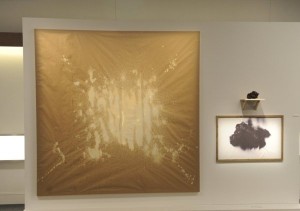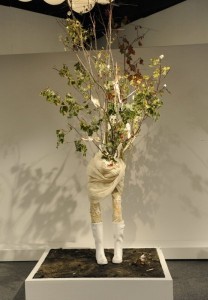By Alicia Eler & Patricia Herrmann
American culture idealizes the beautiful boy as one who lives “between the innocence of babyhood and the dignity of manhood.” Unlike adults, he is alive to “enjoy every second of every minute of every hour of every day…” The beautiful boy can do no wrong. His natural habitat is deep in the idyllic woods, where he gallops about the forest, plays with the animals and jumps, nude, in the watering hole with his boy friends.
Thomas Eakins’ Swimming Hole (1889), a classic example of American realist painting, presents the beautiful boy in his preferred state. Proud and nude, he stands at the edge of the rock with his back turned to the viewer. Is he gazing out onto the landscape, or at the nude boy in front of him who is diving into the water? In this painting of six nude boys playing by the watering hole in the woods we see that the American ideal that lies within the image of that beautiful boy, becomes intertwined with ideas of queerness when viewed by the adult world.
In Episode 9 of Work of Art: The Next Great Artist (WANGA), the five remaining contestants are taken from their studio space in New York City to the Connecticut woods. There they are asked to discover a piece of nature that can be incorporated into their work, thus encouraging them to release their inner beautiful boy. This episode shows us that accessing the beautiful boy in the woods depends upon the artist’s ability to re-connect with their childhood. Additionally, the artists must not remain in the world of the child but bring this world to the world of the adult. The freedom and lack of boundaries of childhood (sexuality, gender) are brought out, but in order to be understood by an audience they must be repositioned into the world of the adult. It is here in the realm of the adult, that this childlike freedom often becomes queer.
THE GIRLS
The inability to fully access childhood for both Jaclyn Santos and Nicole Nadeau was clear in Episode 7: “Child’s Play”, and results in their inability to complete the nature challenge in Episode 9: Natural Talents. Because neither were able to fully access their childhood freedom from bounds they could not transform in the woods into the beautiful boy, the figure necessary to advance to the final round.
Jaclyn Santos’ work throughout the competition has focused on her body and the male gaze—all of her work has been about how she is perceived by the exterior Adult world. In Episode 7, when asked to dig inside and pull something out, all she could cobble together was a weak piece titled Untitled: two paintings that look like Rorschach tests hung on the wall; a string with different colored pipe cleaners hanging off from it stretched across them. Jaclyn attempted to bring meaning to her piece through abstraction. In Episode 9, her work mimics her piece in Episode 7. Titling the piece The End, Jaclyn attempts to express “freedom in nature.” Two paintings of a purple-tinted horizon line complimented by a vast body of water hang on the wall, perpendicular to each other. A rod stretches across the works, positioned a few feet in front of them. A rock attached from a golden clasp is attached to the rod. Like an oversized piece of jewelry, Jaclyn’s piece attempts to access the freedom and play of nature that’s inherent in the beautiful boy icon, but her inability to move beyond the exterior world of adulthood, and into the interior world of the child, relegates this piece to a cold, abstract work of art.
Nicole Nadeau’s work, since the beginning of the show, has been rooted in her connections to nature and design. In Episode 9, however, she demonstrates that she, too, is unable to fully access her childhood. Surfacing Memories, the sculpture that she made in Episode 7, elicits the ghostliness of a Luc Tuymans painting, accessing memory and placing it in the realm of nostalgia rather than actualizing it into the present moment. Placing this piece in the past firmly roots it there, creating a memory that exists only in the hidden spaces of the mind. Through Surfacing Memories, Nicole describes a childhood memory of her and her sister looking into the river, searching for salamanders . Her work in Episode 9 shows a similar disposition. Seemingly overjoyed with the opportunity to enter the woods and run free, it seemed like Nicole would easily advance to the next round. As she is working, however, Nicole gets emotional, and starts talking about her Native American heritage, bringing that into her connection with nature. She has emotionally grasped onto something rooted in her childhood, but the resulting piece doesn’t express it. A glowing egg rests in the middle of an oversized coconut that’s cut in half that’s positioned in a bed of dirt. In the critique, Nicole’s final piece, Mic Mac, does not hold as a complete concept, instead appearing like an emotional crack that will, hopefully, lead to future work. Like Surfacing Memories, Mic Mac scratches at the beginning of an idea and the nostalgia of a memory, but that memory is trapped in the past, inaccessible to the viewer.
For Jaclyn Santos and Nicole Nadeau, the failure to fully realize their concepts, which did have roots in childhood freedom and connection with nature, resulted in an inability to channel the beautiful boy, thus eliminating them from WANGA.
THE BOYS
Miles Mendenhall is the 23-year-old blonde-haired, blue-eyed beautiful boy proudly looking out into the forest. Fresh out of art school, his work throughout the show has been both physically engaging and conceptually driven. What is missing from Miles’ work, however, is a real sense of emotion—each piece is colder and more conceptual than the previous, making his work comparable to Vito Acconci and 1970s performance artists. Particularly calling to mind Vito Acconci’s endurance-based piece Seedbed, 1972.
For Miles, making art seems like an exercise in endurance, especially given his OCD and insomnia. Yet throughout the show, he demonstrates a lust for life, and an ability to keep working despite any physical limitations. In episode 2, Miles says “as long as they’re going to give me free food, good beer, and art supplies, I’ll do what it takes to stick around,” suggesting that he is here not to work but to play. In Episode 9, Miles frolics about the woods, collecting fungus and bringing it back to the studio so that he can look at it from every angle. He is naturally the beautiful boy at play.
ABDI FARAH
Abdi is the only remaining artist of color on Work of Art. Like Miles, he is an energetic 23-year-old boy. The American image of the beautiful boy however is decidedly white. So, unlike Miles, Abdi will have to access queerness, through childhood, in order to successfully evoke the image. Throughout the show, he leans on his Christian faith, and sets himself apart from the stereotypes of young black men, suggesting an aptitude for defying social categories. In Episode 7, he proved that he could access parts of his childhood, even if the resulting image was just a collection of symbols from his childhood as a young man in America: a basketball, a gun, a Nike Swoosh symbol, “Abdi” drawn in bubble letters, a Mighty Ducks logo, a dollar bill sign. In Episode 9, Abdi’s piece, Baptism, a skillfully drawn portrait of him lying down flat, rising above the water evokes baptism. Explaining his piece, Abdi says that the water at the reserve gave him a spiritual awakening. Abdi views the baptism from the world of the adult, failing to bring the childlike freedom to his piece.
PEREGRINE HONIG
Crossing the gender divide to beautiful boy is Peregrine Honig. She has the ability to visually transform her physicality into that of a young boy through short hair and “magical” clothing, and audibly through an ambiguously gendered name. More importantly, her work has an inherent queerness that brings the childlike to the adult world. As an artist, Peregrine is a reflection of the transformation to queerness that childlike freedom undergoes when brought into the adult world.
“The center could not hold,” says Joan Didion in her famous essay, “Slouching Towards Bethelehem.” She continues, stating “It was a country of bankruptcy notices and public-auction announcements and commonplace reports of casual killings and misplaced children and abandoned homes and vandals who misspelled even the four letter words they scrawled.” Didion’s text, though written in 1967, rings true today, reflecting a culture in flux.
It’s impossible for America to keep working off the same model, the same beautiful boy imagery that has been in operation for more than a century. Peregrine Honig’s work invites a new queerness that has been overlooked.
In Episode 7, Peregrine’s piece, Rainbow, brought judge Bill Powers to tears. She accesses childhood naturally and powerfully. And in Episode 9, she titles her piece Golden Gate, relying again upon childhood memories of growing up in a San Francisco hippie commune. Here, the plaster legs of a gender-free child stand on a dirt bed, growing out of boots. A piece of fabric wraps around the figure’s genital-free mid-section, and tree branches grow from there. In the episode, Peregrine says she isn’t sure what this piece is about. She suggests that it’s an annoying teenager, but then later changes her mind, remembering her childhood in San Francisco, seeing people in parks performing sexual acts. She then draws small images of children in varying sexual acts. While the piece was not complete, it evokes the androgynous beautiful boy and his freedom in nature. This work when viewed through the lens of culture is decidedly queer, located somewhere in the gray area between cultural notions of masculine and feminine, between blue and pink.
This episode of Work of Art reflects a new option for a queer future, something magical and unbeknownst to America, but something that America has been curious about since Thomas Eakins’ Swimming Hole, and continues to be to this day. The contest encourages all artists, even those who are not biologically boys, to access nature and the beautiful boy through queer imagery.
Three beautiful boys vie for the title of America’s next great artist. Will queerness triumph?











It’s Rorschach. Not Rorshawk Just sayin.
what an interesting piece of writing that kept me wondering until the end who was able to evoke the images seen through a child’s conciousness. I kept reading, really drawn by the authors’ appreciation of everyone’s work and yet holding strong to the task that was set before these artists. I am left not with a judgement of others’ ability to work but wondering if I have the ability to embrace the world with the innocence of a child. I want that. Thank you for putting ME to that task. A delightful article..thank goodness not a critisism but a celebration. After all how can I judge another if I am not trying to rise to a challenge myself?
What a wonderful take on our televised path. The numbers came in last night -1.48 million watched the final episode, a 20% leap from the previous week. I went to a Primus/ Gogol Bordello / Dead Kenny Gee’s concert the evening before I left for New York. Mark was performing so I had good seats. The concert hall was packed past capacity- 2,300 people bobbed their heads to the music beneath me. I thought “This times six or seven.” Alicia- thank you taking this massive bull of an experiment by the horns and running with it. So many red flags went up and you still charged forward.
I love Gogol Bordello – saw them in Charlottesville on that mini-tour with Primus